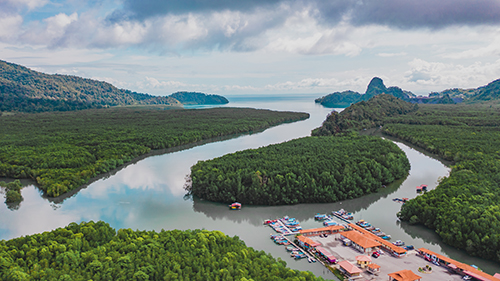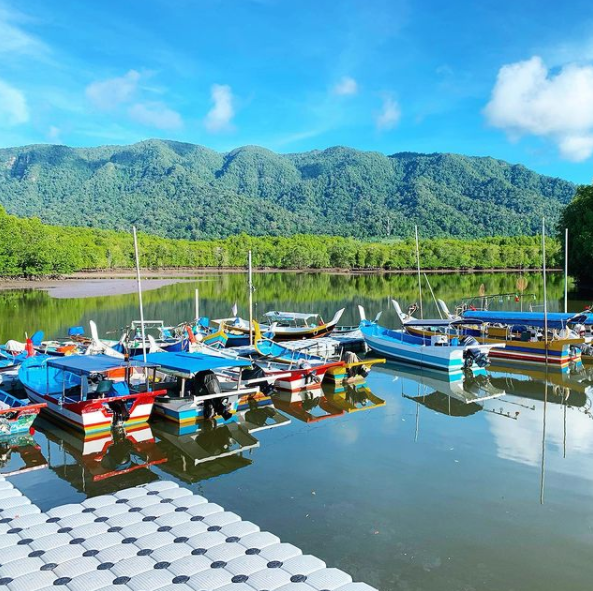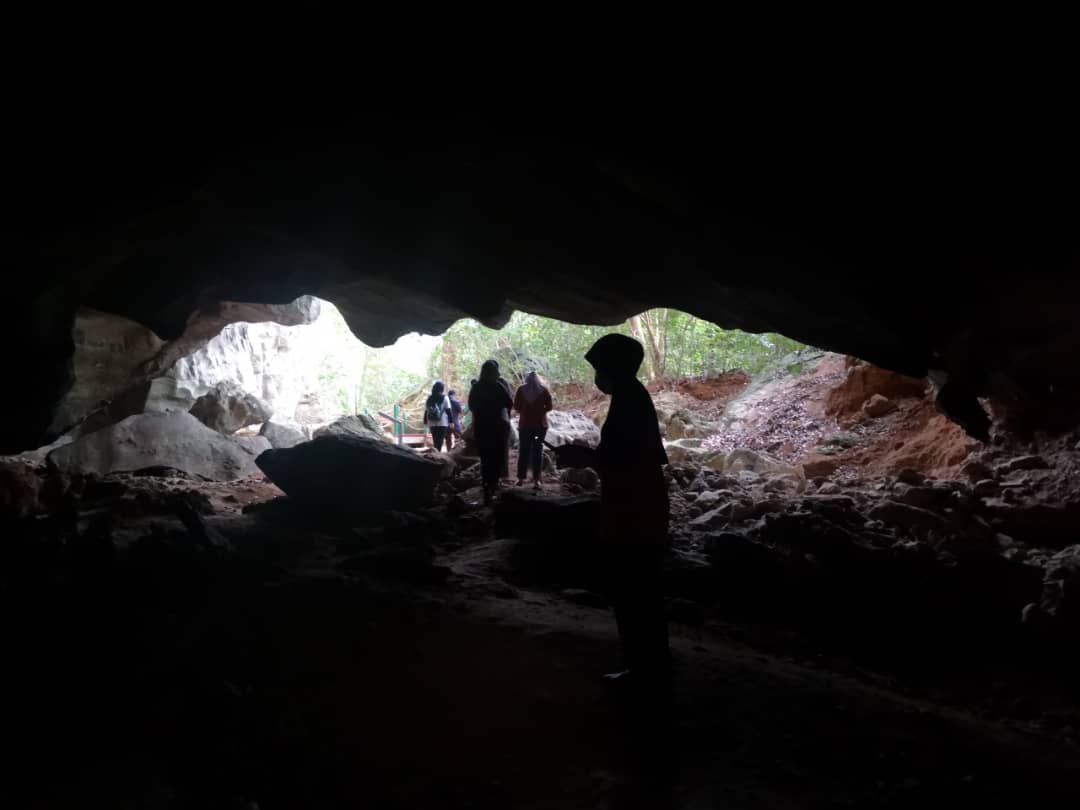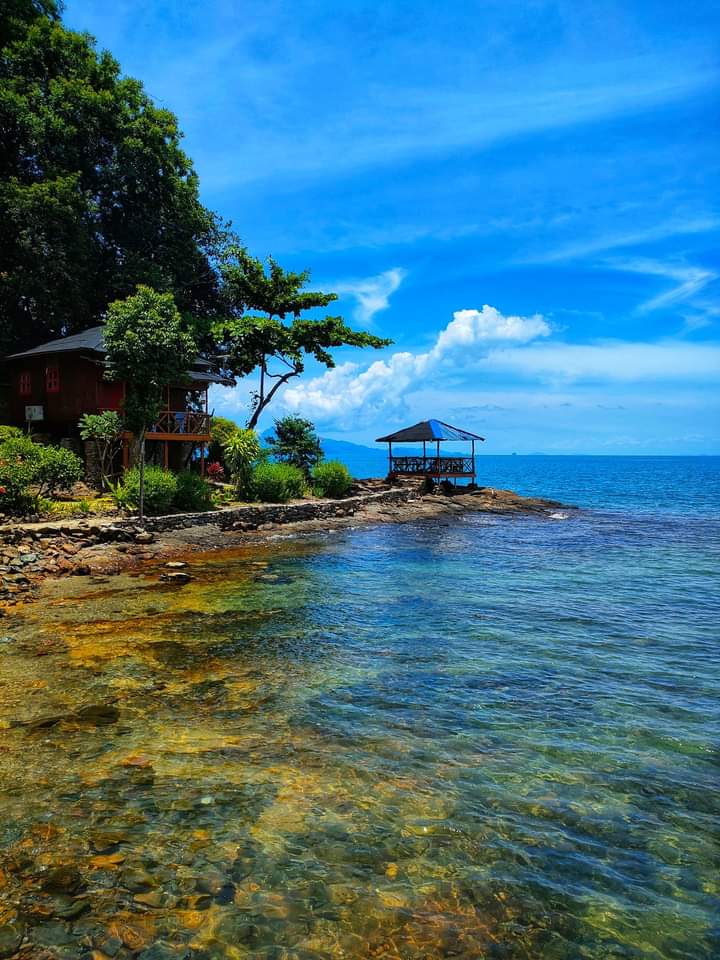
 A view of vast greenery and calm waters holding the natural and cultural heritage of Langkawi.
A view of vast greenery and calm waters holding the natural and cultural heritage of Langkawi.This year’s World Tourism Day has called upon everyone to celebrate “Tourism for Inclusive Growth”, reminding us of how the tourism industry has brought local communities together and opening up opportunities for all walks of life.
A small village located in Southeast Asia’s first UNESCO Global Geopark – Langkawi, fits this year’s theme perfectly. Recently awarded the Heritage Category through PATA Gold Awards 2021, Kubang Badak BioGeoTrail has it all. Home to rich biodiversity, heritage, and culture, Kubang Badak is also blessed with natural resources that have served as the main source of income for its local community.
 The picturesque Kubang Badak Jetty.
The picturesque Kubang Badak Jetty.Kubang Badak’s ecosystem includes vast lands of mangrove forests, a river estuary of great geological diversity, and a settlement with a rich history. It is believed that the origin of its name, Kubang Badak, is derived from “a creature resembling a mighty and powerful rhinoceros (badak) that protected the village from harm.”
The origin of its villagers, on the other hand, can be traced back to the 18th century of an early settlement of the Thai community, considering the village is geographically close to the Thai borders. Due to this, villagers of Kubang Badak are fairly fluent in the Thai language and still share similar arts, culture, and traditions with the Thais. While their main source of income comes from the unique marine resources, the local community has also increasingly involved themselves in tourism and service sectors.
Interested visitors will get to book a guided boat cruise and stop by several special sites. Let’s dive into the deets of Langkawi’s geological treasure!
Have you ever heard of “mogote”? It is a geological jargon that describes steep-sided, isolated, residual hills that are formed by limestone, marble, or dolomite. Kubang Badak’s Bukit Menora is one of them! Situated at Sungai Siam, it is believed that Bukit Menora was the centre of communal activities for the early Thai settlement back in the 18th century. The name, Menora, is from one of the entertainment events that took place, which is a type of dance-drama. Mak Yong and Mek Mulung, which are still well-known and performed in the northern and eastern parts of Peninsular Malaysia, are some examples of Menora.
Evidence of early settlements can be found at Kampung Siam through the remnants of charcoal kilns, when charcoal production was then a thriving industry for the Thai community. The use of charcoal as the main fuel in transport ended in the late ‘80s in Langkawi, after coal and natural gas were introduced. Charcoal production has been prohibited by the Kedah State Forestry Department throughout Langkawi, leaving the kilns at Kampung Siam to age about 100 years today.

Exploring the mystical Gua Pinang.
Many of Kubang Badak’s points of interest are remnants of natural causes, and Gua Pinang is one of them. It is a remnant ancient sea cave formed by waves about 6,000 years ago, when the sea level was 15 metres higher! A proof of this sea-level change can be found on the walls of the cave, where one can find piles of oysters and cockle shells. The animals residing in the cave have evolved to adapt to the cave environment, including reduced organs of visions, loss of body pigment, and a slower metabolism.

Clear waters at Pulau Jemuruk.
Some parts of the oldest rocks in Langkawi are located in Pulau Jemuruk, a remnant island in Kubang Badak. It serves as a geological attraction as the sedimentary rocks of the island represent the top layer of the Machinchang Formation (Mount Machinchang or Mat Chinchang is the second-highest peak in Langkawi and the oldest mountain in Southeast Asia!). Apart from fossil discoveries, Pulau Jemuruk is also a spot for the local community to get their source of food, such as snails and oysters.
A wonder for geologists, Tanjung Buta is one of the sites that are home to fossil discoveries and also a part of Machinchang Formation. One of the most important discoveries here is a 500-million-year-old fossil marker of a trilobite from the Family Saukiidea. Other prominent geological features here include abrasion platforms, sea caves, as well as sandy and pebbled pocket beaches.
To book a complete guided tour of your choice, kindly contact Mr Sabri at +60 12 573 6453.
Photo and information courtesy of Kubang Badak BioGeoTrail. Learn more through Langkawi UNESCO Global Geopark’s Facebook or Naturally Langkawi’s YouTube.